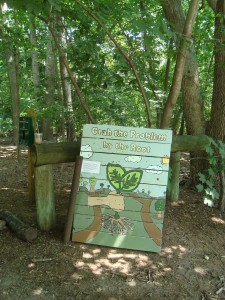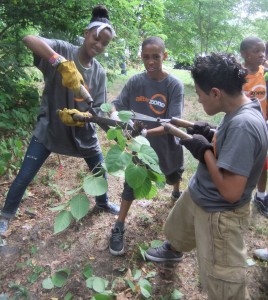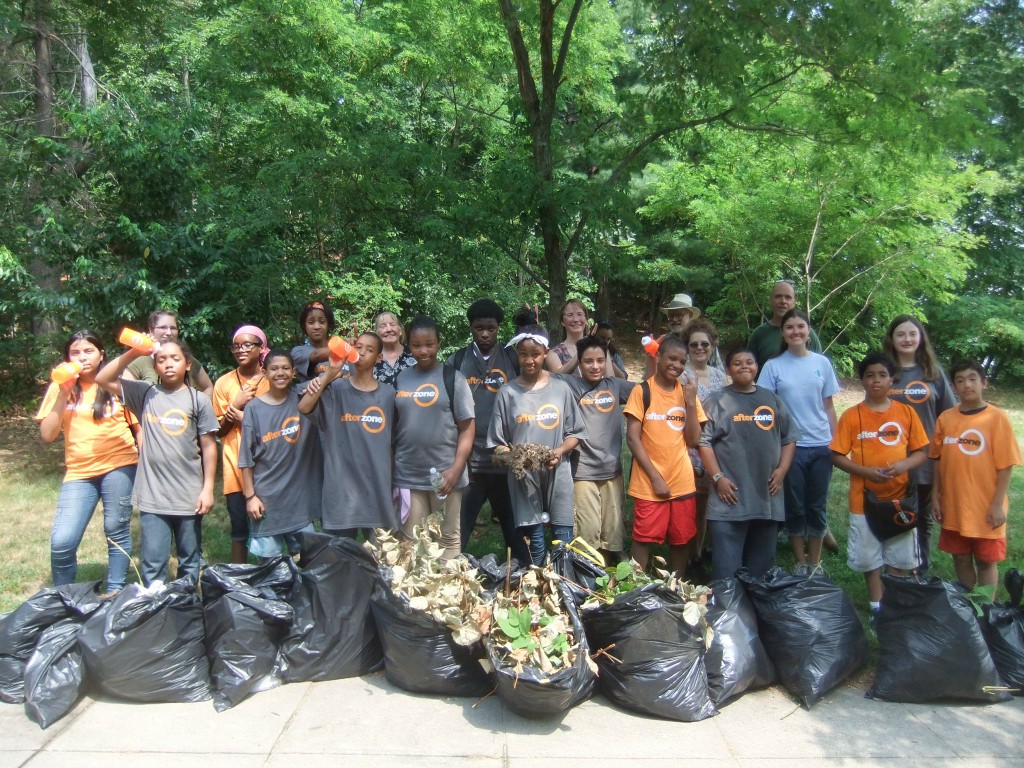 Two mornings a week for four weeks this summer, about 20 middle-schoolers from the Urban Naturalists Program at Nathan Bishop Middle School headed to the Blackstone Park Conservation District to discover something new. In early July next to the Seekonk River at York Pond, it was a baby blue heron and a black crowned night heron. The mud snails and leeches generated less enthusiasm–some kids balked at putting their hands in the water the way Audubon teacher April Alix did.
Two mornings a week for four weeks this summer, about 20 middle-schoolers from the Urban Naturalists Program at Nathan Bishop Middle School headed to the Blackstone Park Conservation District to discover something new. In early July next to the Seekonk River at York Pond, it was a baby blue heron and a black crowned night heron. The mud snails and leeches generated less enthusiasm–some kids balked at putting their hands in the water the way Audubon teacher April Alix did.
In a way, Blackstone Park Conservation District is the kids’ park, for they are among its most enthusiastic visitors. Rain or shine except on the stormiest days during the school year, they visit the park, to observe, learn, and collect data. On the pond visit, they took a water sample to analyze in the classroom for nitrogen, dissolved oxygen, and ammonia. The Providence After School Alliance, PASA, makes it all possible by hiring Audubon to run the program. Nathan Bishop teacher Rick Taylor and PASA Program facilitator Eva Dayon also work closely with the kids.
On one of the swampiest days of the summer, July 18th, the urban naturalists did hand-to hand combat with Japanese knotweed, one of the most formidable invasive plant species in the park. This plant cannot be controlled with herbicides. In the north section at Irving Avenue, where a patch at wood’s edge has been barely kept under control with mowing by the Providence Parks Department and digging by BPC volunteers, one could see how knotweed drives out other species.
 A few Blackstone Parks Conservancy volunteers explained the need to push back against invasives like knotweed and Asian bittersweet before they can establish a footing inside the woods, where they are even harder to control than they are at its edge.
A few Blackstone Parks Conservancy volunteers explained the need to push back against invasives like knotweed and Asian bittersweet before they can establish a footing inside the woods, where they are even harder to control than they are at its edge.
Until this summer, the 12-to-14-year-olds had no idea what an invasive plant was. But now they did, and the idea of protecting the woodland that they love caught their fancy. Teachers showed them pictures of knotweed over six feet tall, packed tightly like soldiers at drill. Some of the boys seized on the idea of front lines. Kids had to be reminded to stop for water as they went after what they dubbed “the mother lode.” Spurring each other on in a competition to fill the most large garbage bags, they filled nearly a dozen and proudly posed behind them.
“The kids have to be passionate about nature” to do this, says Alix, who studied zoology in college and is occasionally mistaken for one of the kids. City dwellers all, they have to be willing to step into the unknown. Unlike Alix, who grew up in Bristol, many of them had never held an earthworm or seen a heron and none had dug up an invasive root before this program. Sometimes nature can seem scary. Gradually, says Alix, the fear dissipates and a sense of accomplishment takes over. By The end of the program they realized that now knew more about invasive plants species than many adults.
For the kids’ account of their battle with knotweed, see their Blog.
Jane Peterson




